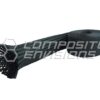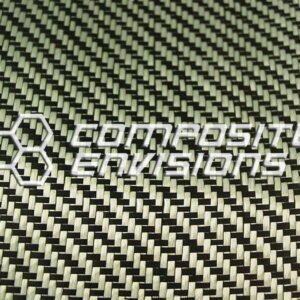Description
This Fabric is Aerospace Grade. This fabric is woven into a tube/sleeve so you can easily make straight or curved pipes with no seams. This sleeving has a tow size of 3k which will yield a lighter and easier to work with fabric. Thickness is 0.013″/.33mm. These carbon sleeves have a 34Msi Modulus stiffness with a 640ksi Tensile strength.
This sleeve is available in 0.25″, 0.5″, 0.75″, 1″, 1.5″, 2″, 2.5″, 3″, 4″, 6″ Diameters.
To harden the raw fabric into a usable form, you will need the appropriate resin or epoxy for your project.

Sharx™ braided sleeving easily and repeatedly conform to the shape of products with changing geometries like prosthetics and hockey sticks, improving overall performance, minimizing weight, and maximizing strength. A sleeving takes on the exact shape and dimensions of the part over which it is pulled. When the sleeving is pulled over a part with changing cross-sections the fiber orientation, the thickness, and the yield of the braid vary at each point along the length of the part. These variations are predictable and repeatable and lend themselves to easy and precise manufacture of composite parts.
Sharx™ braid is seamless, so all fibers within the reinforcement work together to carry the load. The fibers in Sharx™ sleevings orient themselves to follow the load path. For instance, a 2″ diameter sleeving used to manufacture a goalie stick pulls down to 1.1″ over the handle resulting in a low angle which increases the stiffness. As this same sleeving is pulled over the blade of the goalie stick, the braid diameter increases to 2.3″ resulting in a 54.4 degree angle and increased impact resistance.
Woven Biaxial Sleeves can contract and expand when pulled or pushed resulting in a smaller diameter and longer length or a larger diameter and shorter length. As a result of this it is very difficult to measure woven sleeves by length when cutting. Measuring by length can result in a final cut length off by /- 25% or more. To account for this problem we weigh all our sleeves and cut based on the weight not the length. This will result in a more accurate final cut length. Still using this method, lengths may be off by /- 5%.
This item is sold by the linear yard (verified by weight). Each qty will yield a 36″ long piece. If you order more than one, we will leave the sleeve in a continuous piece.
These sleeves will expand in diameter if the ends are pushed together and also will decrease in diameter if pulled from both ends.







Reviews
There are no reviews yet.